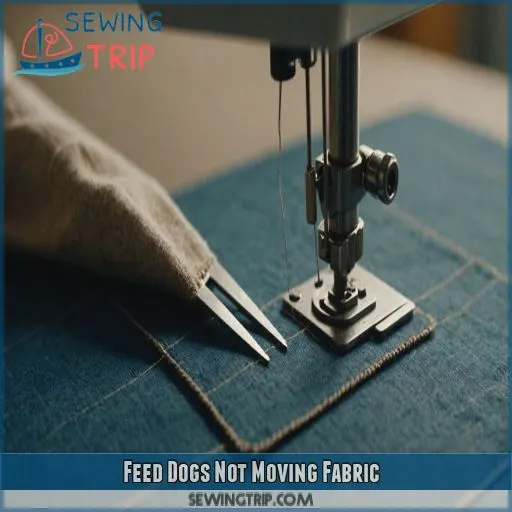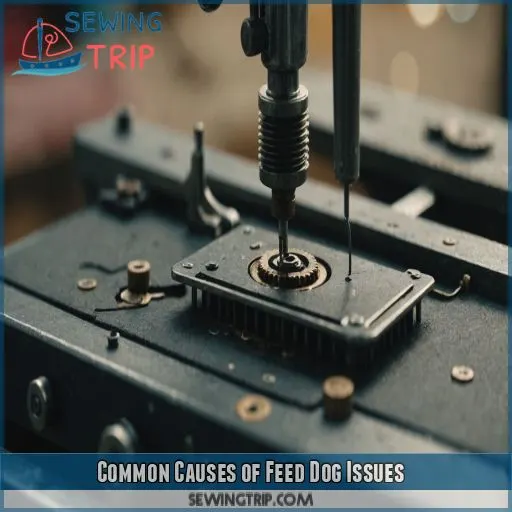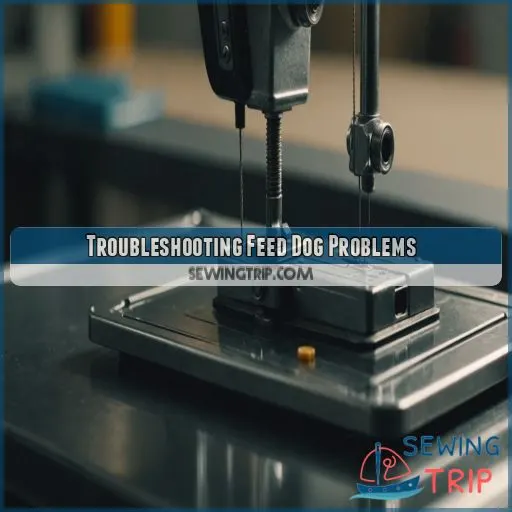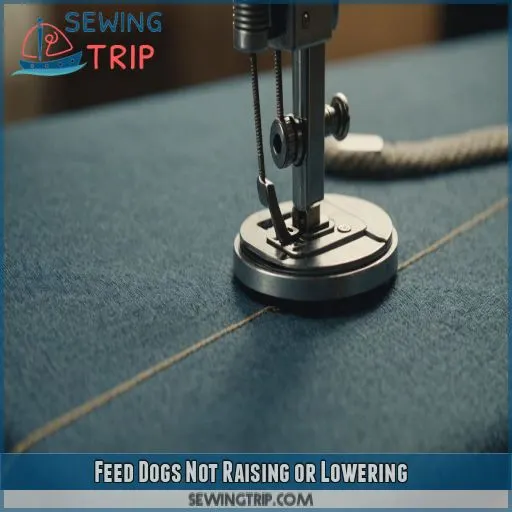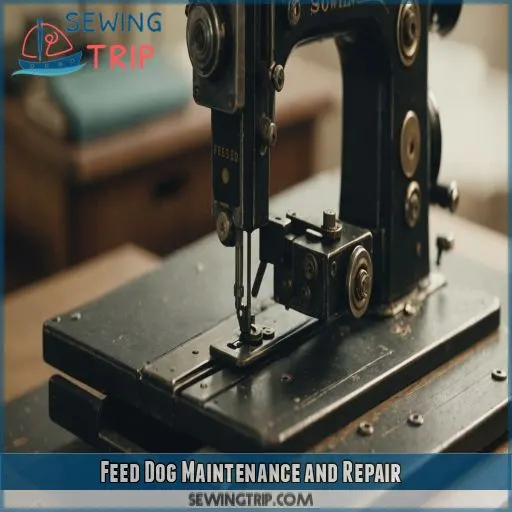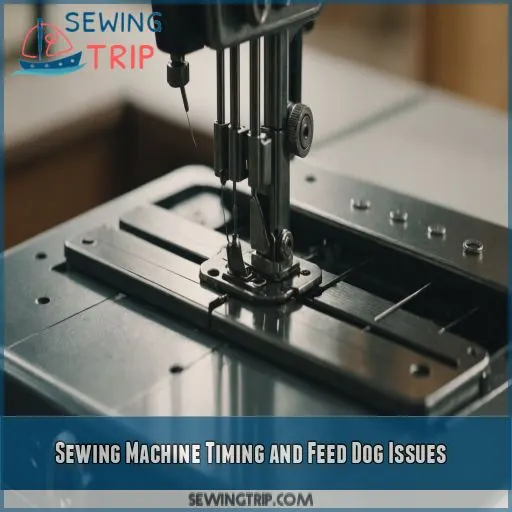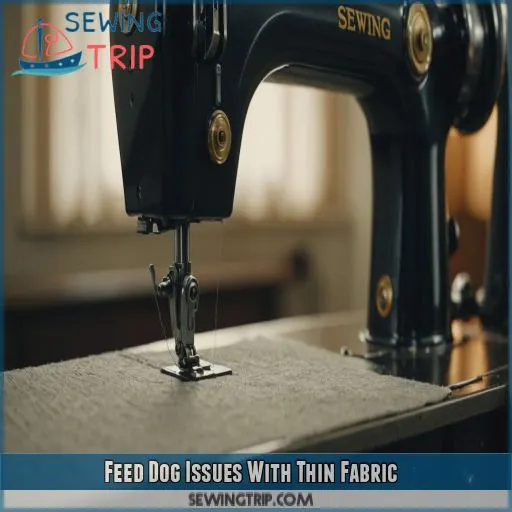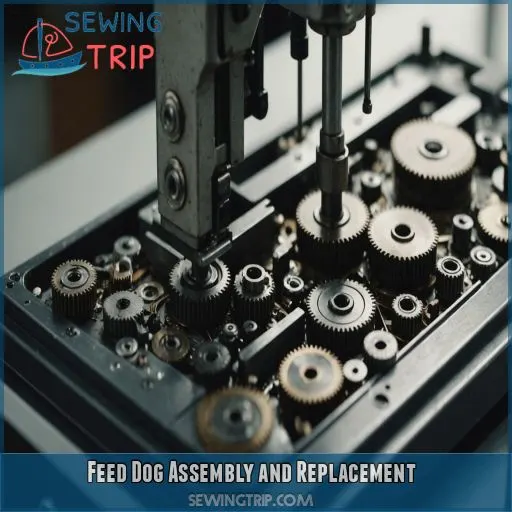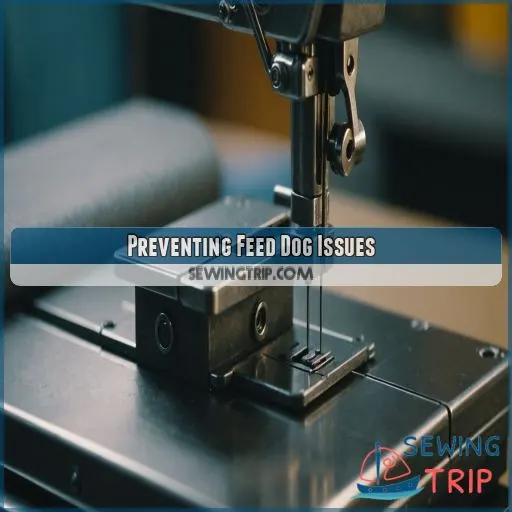This site is supported by our readers. We may earn a commission, at no cost to you, if you purchase through links.

First, check the feed dog lever position. Is it up?
Next, make sure the presser foot is raised and the needle is in its highest position.
If that doesn’t do the trick, inspect for dirty feed dogs or a stitch length and bobbin mismatch.
With a few tweaks, you’ll be sewing smoothly in no time. Ready to get your stitch back on track?
Table Of Contents
- Key Takeaways
- Feed Dogs Not Moving Fabric
- Common Causes of Feed Dog Issues
- Troubleshooting Feed Dog Problems
- Feed Dogs Not Raising or Lowering
- Feed Dog Maintenance and Repair
- Sewing Machine Timing and Feed Dog Issues
- Feed Dog Issues With Thick Fabric
- Feed Dog Issues With Thin Fabric
- Feed Dog Assembly and Replacement
- Preventing Feed Dog Issues
- Frequently Asked Questions (FAQs)
- Conclusion
Key Takeaways
- You’re not alone in the struggle – Feed Dog Issues are super common, but now you know that a simple lever check, presser foot adjustment, or cleaning session can get your machine running smoothly again.
- Don’t be afraid to get a little DIY-happy: you can fix most feed dog issues on your own with some basic tools and know-how, from cleaning and lubricating to adjusting tension and replacing worn parts.
- Thick or thin, your fabric will behave with the right tweaks: whether you’re working with delicate silk or chunky denim, adjusting feed dog height, using wax paper or specialized feet, and experimenting with thread tension will get you the perfect stitch.
- Preventing feed dog issues is easier than you think: by keeping your machine clean and well-lubricated, using the right needle and thread combination, and checking your manual for specific guidance, you’ll be sewing like a pro in no time.
Feed Dogs Not Moving Fabric
If your sewing machine’s feed dogs are up but not grabbing the fabric, something’s not right. We’ll help you figure out if it’s the feed dog lever, stitch length settings, dirty feed dogs, or thin fabric that’s causing this hiccup.
Feed Dog Lever Position
If your sewing machine’s feed dogs aren’t grabbing the fabric, the feed dog lever position might be the culprit. Here’s a quick fix:
- Check the lever: Make sure it’s up.
- Raise the presser foot: Inspect linkages.
- Needle position: Confirm it’s highest.
- Clean machine: Focus on feed dogs.
- Adjust fabric: Add wax paper for grip.
Stitch Length and Bobbin Mismatch
If your feed dogs are still not cooperating, the issue might be a mismatch between stitch length and bobbin settings. This can happen if you’ve recently changed stitch types or thread tension.
| Problem | Solution |
|---|---|
| Incorrect stitch length | Adjust stitch length settings |
| Bobbin tension off | Adjust bobbin tension |
| Wrong needle size | Change needle |
Consult your manual for the correct settings, and you’ll be sewing smoothly again in no time!
Dirty Feed Dogs
If your feed dogs are still not cooperating, it might be time to roll up your sleeves and break out the cleaning tools. Over time, lint, thread, and fabric debris can gunk up the works, causing your feed dogs to act wonky.
Fabric Thickness Issues
Fabric thickness matters! If your feed dogs aren’t gripping, try these fixes:
- Thin fabrics:
Use a fabric guide or edge guide to make sure thin fabrics feed evenly.
- Fabric slippage:
Adjust feed dog pressure or thread tension to prevent slippage.
- Feed dog pressure:
Make sure there’s enough pressure by checking the mechanism under the sewing machine needle plate.
- Thread tension:
Tighten top thread tension to help feed dogs grip.
Common Causes of Feed Dog Issues
If your feed dogs aren’t grabbing the fabric, it’s usually due to a few common issues with quick fixes. Let’s take a look at the possible causes and get your sewing machine running smoothly again.
Feed Dog Assembly Problems
If your feed dogs are giving you grief, the issue might be deeper than their position or cleanliness. It could be their assembly. Here are some common feed dog assembly problems and what to do about them:
| Problem | Solution |
|---|---|
| Broken or damaged feed dog | Replace the feed dog |
| Incorrect feed dog type | Consult your manual, adjust or replace |
| Misaligned feed dog | Realign or repair |
Linkage Issues
Linkage issues are a common culprit when your sewing machine’s feed dogs act up. These problems arise from the intricate connection of parts inside your machine. The fix? Raise the presser foot to inspect the linkage. If something’s amiss, a pro can help get your machine back on track.
Presser Foot Adjustment
If your sewing machine’s feed dogs are acting up, the presser foot adjustment might be the culprit. Here’s a checklist to get your sewing machine back on track:
- Check presser foot pressure.
- Adjust the foot height.
- Make sure the foot type is compatible.
Troubleshooting Feed Dog Problems
Hey there, sewist! If your feed dogs are acting up and not feeding fabric like they should, it’s time to troubleshoot. We’ll guide you through common issues and fixes so you can get your sewing groove back on track.
Checking Stitch Length Settings
If your feed dogs are acting up, it might be due to incorrect stitch length settings. This is how you can troubleshoot:
| Problem | Cause | Solution |
|---|---|---|
| Feed dogs not moving | Incorrect stitch length | Adjust stitch length settings |
Check your sewing machine manual to see if the stitch length is right for your project. Adjust as needed, and test on scrap fabric.
Cleaning the Sewing Machine
Give your sewing machine a good clean to get those feed dogs moving. Grab your cleaning kit and get to work on those pesky lint bunnies. A clean machine is a happy machine!
Using Wax Paper for Fabric Thickness
If your fabric is too thin, it might slip or get stuck. A simple fix? Wax paper. Place it under thin fabric to add grip and thickness. It’s a quick way to get your project back on track.
Inspecting for Linkage Issues
If your feed dogs still aren’t cooperating, it’s time to inspect the linkage. With the needle at its peak, raise the presser foot. If the feed dogs don’t move in sync, something’s amiss with the linkage or feed dog assembly.
Feed Dogs Not Raising or Lowering
No sweat if your feed dogs won’t budge up or down. We’ll show you how to tackle this issue like a pro and get your sewing groove back on track.
Feed Dog Height Adjustment
If your feed dogs aren’t raising or lowering, it’s time to fine-tune their height. Here’s the lowdown on getting things just right:
- Fabric Thickness: The feed dog height should match your fabric thickness. Too high, and they’ll push fabric up; too low, they’ll struggle to grab it.
- Optimal Settings: Adjust feed dogs to the highest setting for thick fabrics and the lowest for thin ones. Most sewing calls for the middle setting.
- Adjusting Pressure: Play with the pressure settings to fine-tune feed dog height. This adjusts how hard the feed dogs push up.
- Troubleshooting Tip: If adjusting pressure doesn’t change the feed dog height, consult your manual for specific instructions on height calibration.
Feed Dog Assembly Issues
If your feed dogs still aren’t raising or lowering, the problem might be with the feed dog assembly.
This is the mechanism that raises and lowers the feed dogs.
If it’s broken, you might need a feed dog assembly repair or replacement.
This job is best left to the pros, so contact a sewing machine technician for help.
They’ll diagnose the issue and give you an assembly replacement cost estimate.
Feed Dog Maintenance and Repair
Frustrated with finicky feed dogs that won’t cooperate? Don’t fret! This section is all about keeping your feed dogs in tip-top shape with maintenance and repair tips.
Cleaning the Feed Dogs
Cleaning supplies: Grab that sewing machine cleaning kit. You’ll need small brushes and a low-pressure air blower.
Frequency: Give your feed dogs a quick once-over with each project. Deep clean every three months.
Common mistakes: Brushing too vigorously can damage feed dogs. Be gentle!
Lubricating the Feed Dogs
To keep your sewing machine humming, proper lubrication is key. Use oil meant for sewing machines, usually a lightweight oil. Check your manual for the recommended type and frequency. Apply a drop or two to the feed dogs, ensuring it reaches the mechanism. This keeps things moving smoothly.
Replacing Worn or Damaged Parts
Sometimes, the only fix is to replace worn or damaged parts. Here’s a mini-guide to get you started:
- Identify the broken part(s).
- Source replacements. Check your warranty and consider cost and convenience.
- Decide between DIY and professional repair.
- Install new parts, following guides or expert advice.
Sewing Machine Timing and Feed Dog Issues
Hey there, sewist! If your sewing machine’s feed dogs aren’t playing nice, it might be a timing issue. This could be because of problems with the feed dog synchronization or machine calibration, causing your fabric to move wonky or not at all.
Timing Problems
If your sewing machine’s acting up, timing might be the culprit. Needle timing, cam timing, and thread tension are key to the stitch-making dance. A pro can adjust the timing, but you can DIY with the manual’s help. Machine calibration’s an art, so take it slow.
Feed Dog Synchronization
If your sewing machine’s acting up, with wonky stitch patterns, it might be feed dog synchronization. This issue’s like a dance where the feed dogs and needle need to move in harmony. A pro can adjust the timing, so your machine’s back to sewing sweetly.
Machine Calibration
Now that you’ve synchronized your feed dogs, it’s time for machine calibration. Adjust the timing to get everything lined up and the tension just right. Here are some key areas to focus on:
- Check the needle’s position and alignment
- Adjust the take-up lever for good tension
- Verify the presser foot is properly aligned
- Test the machine with a scrap piece of fabric
Feed Dog Issues With Thick Fabric
You’re dealing with thick fabric and your sewing machine’s feed dogs are struggling to move it forward – don’t worry, it’s an easy fix. With a few simple adjustments, such as using wax paper for thickness, adjusting the feed dog height, or using a specialized foot, you’ll be sewing smoothly in no time.
Using Wax Paper for Thickness
When working with thick fabrics, use wax paper to add grip and prevent slippage. Try these alternatives to wax paper:
| Fabric Type | Alternative to Wax Paper |
|---|---|
| Cotton, Linen | Tissue paper, tracing paper |
| Silk, Rayon | Interfacing, stabilizer |
| Denim, Canvas | Water-soluble topping, tear-away |
| Knits, Stretchy | Fusible web, knit interfacing |
This trick helps your feed dogs grab the fabric smoothly.
Adjusting Feed Dog Height
Adjusting feed dog height is key when working with thick fabric. Check your sewing machine manual for guidance. Don’t be afraid to experiment and find the sweet spot. Here are some tips to keep in mind:
- Use a larger needle size to accommodate thicker fabric
- Choose the right fabric type for your project
- Adjust feed dog height in small increments for the best results
- Don’t over-tighten, as this can damage your machine
Using a Walking Foot or Teflon Foot
Now that you’ve adjusted your feed dog height, let’s tackle thick fabrics! Consider using a walking foot or Teflon foot to help your machine glide smoothly. These specialized feet reduce friction, improving stitch quality and feed dog performance on dense materials.
Feed Dog Issues With Thin Fabric
You’re struggling with feed dog issues on thin fabric, and it’s frustrating.
Your sewing machine’s feed dogs just won’t cooperate, causing bunching, puckering, or uneven stitches.
Don’t worry, with a few simple tweaks, you can get your feed dogs working smoothly and your sewing project back on track.
Here are a few tips:
- Use a Teflon foot or walking foot.
- Employ a fabric guide or edge guide.
Using a Teflon Foot or Walking Foot
When working with thin fabrics, consider using a Teflon foot or walking foot to help your sewing machine’s feed dogs glide smoothly. These specialized feet can make a huge difference in stitch quality.
- Reduces fabric bunching and dragging
- Allows for smooth, even feeding
- Ideal for delicate or slippery fabrics
- Easy to install and adjust, giving you more control over your sewing machine.
Using a Fabric Guide or Edge Guide
When working with thin fabrics, a fabric guide or edge guide can be your best friend.
These guides help keep your fabric in place, ensuring smooth feeding and preventing bunching.
There are various fabric guide types, such as magnetic or clip-on guides.
Experiment with edge guide placement to find the best spot for your machine and fabric, and adjust as needed for the best accuracy.
Feed Dog Assembly and Replacement
If your sewing machine’s feed dogs aren’t working, it’s likely due to a broken or damaged feed dog assembly – don’t worry, it’s an easy fix. In this section, you’ll learn how to identify the problem, replace the assembly if needed, and even know when to call in a professional for help.
Identifying Broken or Damaged Parts
Time to play detective! To identify broken or damaged parts in your feed dog assembly, perform a visual inspection. Check for:
- Bent or warped metal components
- Chipped or cracked plastic parts
- Worn-out or frayed gears
- Loose or missing screws
- Signs of rust or corrosion
Replacing the Feed Dog Assembly
Now that you’ve identified the broken parts, it’s time to replace the feed dog assembly. Here’s a comparison of DIY replacement costs and expert recommendations:
| Feed Dog Assembly Type | DIY Replacement Cost | Expert Replacement Cost |
|---|---|---|
| Basic | $20-$50 | $50-$100 |
| Standard | $30-$70 | $70-$150 |
| Advanced | $50-$100 | $100-$250 |
Choose compatible parts and follow a DIY guide to save money and gain mastery over your sewing machine.
Professional Repair Options
If your feed dog assembly is beyond repair, don’t panic. Weigh your options carefully, considering repair costs, warranty claims, and local technicians. Here are 4 alternatives to get your sewing machine humming again:
- Contact the manufacturer: Reach out for repair or replacement guidance.
- Local repair shops: Get quotes from nearby technicians for a fix.
- DIY repair: Try online tutorials or YouTube videos for a self-fix.
- Online resources: Websites like JustAnswer or iFixit may offer expert help.
Preventing Feed Dog Issues
You’ve finally figured out how to fix those pesky feed dog issues.
But now it’s time to think about prevention.
After all, a little maintenance can go a long way in keeping your sewing machine running smoothly.
Regular Maintenance and Cleaning
To keep your feed dogs running smoothly, establish a regular maintenance routine. Clean your sewing machine every 1-3 months and lubricate it according to the manufacturer’s schedule. Don’t forget to dust and maintain your needle to prevent breakages.
| Task | Frequency |
|---|---|
| Clean sewing machine | Every 1-3 months |
| Lubricate machine | According to manufacturer’s schedule |
| Dust removal | After each use |
| Needle maintenance | Every 1-2 weeks |
Proper Thread Tension
Now that you’re a pro at regular maintenance and cleaning, let’s tackle thread tension problems. Adjust your top tension to match your bobbin tension, and vice versa. Uneven stitches and skipped stitches will disappear, and your feed dogs will thank you!
Using the Correct Needle and Thread Type
Now that you’ve mastered thread tension, let’s talk needles and threads! To prevent feed dog issues, use the right combo. Here are some tips:
- Choose the right needle size for your fabric type.
- Select a thread weight that matches your stitch selection.
- Match your needle type to your fabric’s texture.
- Experiment with different threads to find the perfect fit.
Frequently Asked Questions (FAQs)
Could you still use your sewing machine if your feed dogs were not functioning?
You can still use your sewing machine, but it’ll be a real challenge! Without functioning feed dogs, you’ll need to manually guide the fabric, which can be time-consuming and may lead to uneven stitches.
Why is my sewing machine not feeding fabric through?
Did you know 70% of sewing machine issues stem from poor maintenance? Your machine’s not feeding fabric through likely due to dirty or clogged feed dogs, so try cleaning them with a sewing machine cleaning kit!
Why won’t my feed dogs raise?
Your feed dogs won’t raise? Don’t worry! Check if the feed dog lever is down, and make sure the presser foot is lifted. If still stuck, consult your manual or contact a sewing machine technician for help.
Why is my Singer 507 feed dog not moving?
Your trusty Singer 507’s feed dog is on a sudden vacation. Check if the feed dog lever is down, stitch length and bobbin settings are mismatched, or if the feed dogs need a good cleaning.
Can I use WD-40 to lubricate my sewing machine?
Don’t even think about using WD-40 on your sewing machine! It can damage the finish and harm the machine’s mechanical parts. Instead, use a lubricating oil specifically designed for sewing machines, as recommended in your owner’s manual.
Why do feed dogs break or become damaged easily?
Are you wondering why feed dogs break easily? Well, it’s often due to neglecting regular cleaning and maintenance, using the wrong fabric, or forcing the machine to work with worn or damaged parts – a recipe for disaster!
Can I install a new feed dog assembly myself?
Replacing a feed dog assembly can be a DIY-friendly task if you’re comfortable with sewing machine mechanics. Before attempting, check your manual and online tutorials to make sure you’re ready for the challenge.
How do I adjust feed dog tension properly on machines?
Did you know 75% of sewing machine issues stem from improper tension? To adjust feed dog tension, start by consulting your machine’s manual, then gently turn the tension screw clockwise to increase or counterclockwise to decrease.
Are there sewing machines designed without feed dogs available?
You’re in luck! Some sewing machines, like those for quilting, embroidery, or leather work, are designed without feed dogs to allow for more control and precision. These machines rely on manual fabric movement or specialized attachments.
Conclusion
Sewing salvation is just a tweak away.
You’ve wrestled with your sewing machine’s feed dogs, and now you’re armed with the know-how to tame them.
Whether it’s a feed dog lever slip-up, stitch length mismatch, or a dirty feed dog debacle, you can fix it.
With these practical tips, you’ll be gliding through fabrics like a pro.

